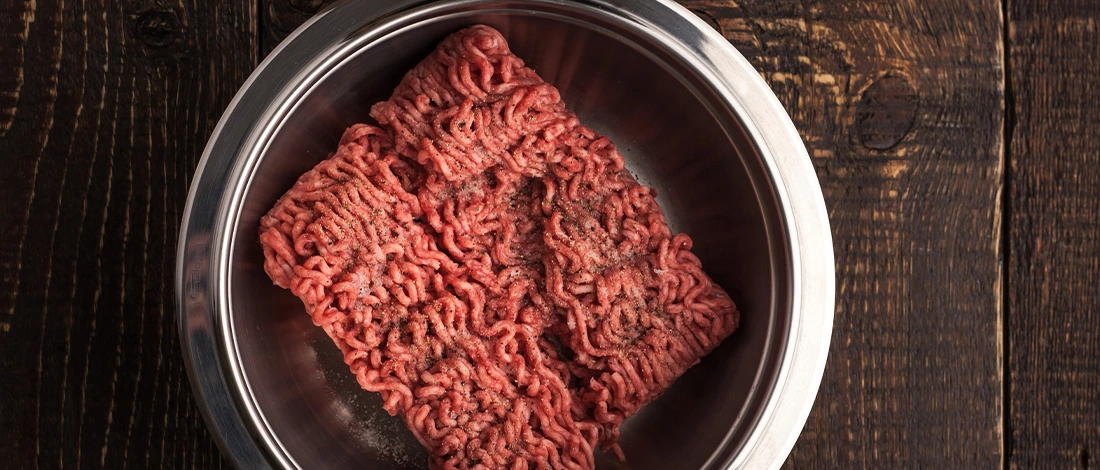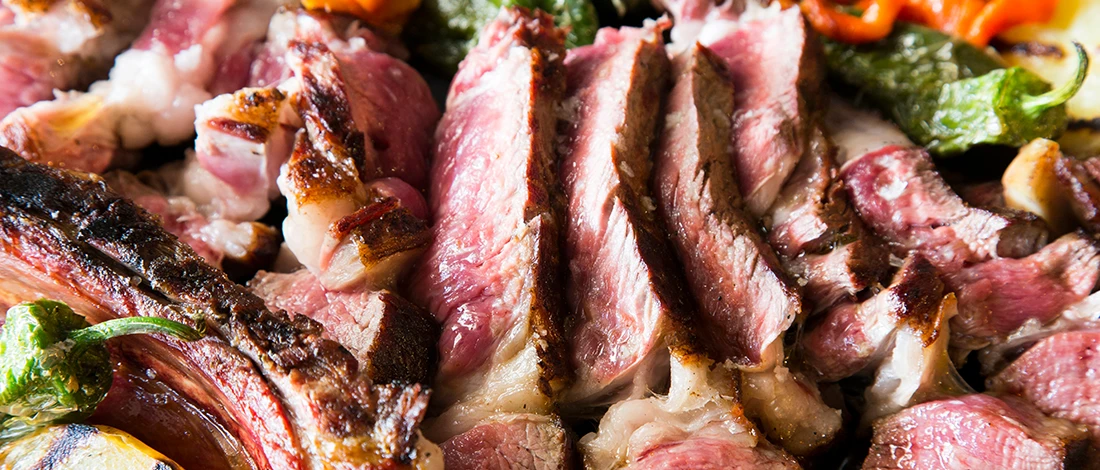At Carnivore Style, we know that being on a carnivore diet means eating a lot of light and dark meat, especially beef.
However, I’ve been paying more attention to eating healthy, so I considered substituting ground beef with ground turkey.
I talked with a nutritionist to identify the healthier choice and checked the nutritional information for ground turkey and beef to make an informed decision.
Read on to learn about how their flavors, cooking methods, and nutritional value differ.
Quick Summary
- Ground turkey and beef have similar nutritional profiles.
- Ground turkey is slightly healthier than beef because it has less saturated fats.
- Ground turkey and beef have different flavors, with turkey having a bland taste.
The Differences between Ground Turkey vs. Ground Beef

Ground turkey is often used as a healthier substitute for ground beef. However, ground turkey isn’t much healthier compared to ground beef.
The swap isn’t worth it unless you’re using 100% fat-free ground turkey instead of particularly fatty ground beef.
It’s always best to use lean cuts for turkey and beef and buy quality meat from trustworthy sellers. ButcherBox sells humanely raised and sustainably sourced meat. Carnivore Style recommends this service because their beef is 100% grass-fed and grass-finished, and the poultry is raised crate-free.
Also Read: Ground Chuck vs Ground Beef
1. Nutritional Value

Here’s the nutritional profile of both ground meats and how they differ.
Ground Beef
Depending on the beef you use, it can have between 20% to 30% or only 7% fat (when you use leaner cuts, such as sirloin) [1].
Here’s the nutritional profile of 3 oz 70/30 ground beef:
- Calories: 235
- Protein: 22 g
- Total fat: 16 g
- Saturated fat: 6.2 g
- Carbs: 0
- Fiber: 0
- Cholesterol: 75 mg
- Sodium: 69 mg
- Magnesium: 19 mg
Here’s the nutritional profile of 3 oz of 93/7 ground beef (the leanest ground beef you can find):
- Calories: 178
- Protein: 25 g
- Fat: 8 g
- Saturated fat: 3.3 g
- Carbs: 0
- Fiber: 0
- Cholesterol: 76 mg
- Sodium: 73 mg
- Magnesium: 28 mg [2]
Ground Turkey
Ground turkey is usually made of light and dark meat and has about 7% fat, but very lean turkey comes from turkey breast and has about 1% fat [3].
Here’s the nutrition profile of 3 oz of 93/7 ground turkey:
- Calories: 181
- Protein: 23 g
- Total fat: 10 g
- Saturated fat: 2.5 g
- Carbs: 0
- Fiber: 0
- Cholesterol: 88 mg
- Sodium: 77 mg
- Magnesium: 29 mg
Overall, the nutritional profiles of lean ground turkey and beef are very similar, with lean meat from ground beef having more saturated fats.
The biggest difference is between fat-free ground turkey and 70/30 ground beef. By choosing lean ground turkey, you cut down on saturated fat by over half than by choosing ground beef.
Related Articles:
2. Flavor
Even though ground beef and turkey have similar nutritional profiles, their flavors are different.
Ground Beef
Ground beef has a stronger flavor than turkey. Beef has a richer and more savory profile. This is because ground meat that comes from chuck and sirloin is naturally juicier than turkey.
Ground Turkey
Ground turkey tastes blander than ground beef. This is a good choice if you want meat with a lighter flavor where it won’t overpower the ingredients.
Ground turkey is also drier and chewier than beef. It’s best used instead of beef in tacos, casseroles, and dishes with many seasonings and ingredients. Once ground turkey is well-seasoned, it’s hard to tell the difference between it and beef.
3. Heart Health

Both beef and turkey can have a huge impact on heart health.
Ground Beef
Eating foods high in saturated fat leads to heart disease because it raises the LDL cholesterol (the bad cholesterol) [4].
Ground beef has a higher fat percentage than ground turkey, especially saturated fat, so if you have heart disease or are at risk of developing it, ground beef, especially the 70/30 kind, isn’t the best choice.
Ground Turkey
Ground turkey has less saturated fat than beef. Turkey has one gram less saturated fat compared to beef, so it’s a better choice for heart health.
4. Weight Loss
These two types of meat can play a significant role in weight reduction.
Ground Beef
Eating a lot of protein helps make you feel full for longer, which helps with weight loss.
Ground beef is rich in protein. Choose lean ground beef for lower fat percentages to lose weight.
Ground Turkey
Ground turkey is a better choice than beef when trying to lose weight. Fat-free turkey has the least amount of calories and the most protein. Moreover, it has an equal or higher amount of protein than any kind of beef.
Cook with 99% fat-free turkey, as this is the leanest option with the least calories.
Also Read: Carnivore Diet Weight Loss
5. Dryness

Depending on the type of meal you want to make, you will want to decide which one of these two to use.
Ground Beef
Ground beef isn’t very dry, especially if you use a sirloin or a chuck cut. You can use it to make a beef burger, tacos, and other foods.
Ground beef is more forgiving than turkey and has a slightly higher fat content, so you don’t have to worry it’ll be too dry.
Ground Turkey
Ground turkey has a lower fat content than beef. Less fat means less moisture, which means turkey can get dry quickly. If this happens, it loses flavor, and you have crumbly ground meat.
You need to be very careful when cooking a turkey burger and other dishes, and pay special attention to the cooking temperature, so you don’t end up with dry meat.
6. Cooking Differences
Lastly, beef and turkey require different cooking methods.
Cooking Ground Beef
Ground beef generally is done when it reaches an internal temperature of 160 degrees [5].
Beef doesn’t need a lot of seasonings or sauces, but you can use them if you want to have a richer flavor.
Cooking Ground Turkey
Ground turkey is cooked when it reaches an internal temperature of 165 [6].
“Make sure your turkey reaches an internal temperature of 165 F. Use a food thermometer to measure the internal temperature in three parts: the thickest part of the breast, the innermost part of the wing, and the innermost part of the thigh.”
- United States Department of Agriculture
If you’re substituting turkey instead of beef, don’t expect the dish to taste the same. It’s best to use ground turkey in dishes where the beef isn’t the main flavor.
But, if the meat is the main flavor, for example, in a burger, you should season the turkey to make up for the turkey's natural blandness.
Use salt, black pepper, garlic, onion, and chili powders. You can also use Worcestershire sauce to bring out the meaty flavor of the turkey.
FAQs
Is Ground Beef or Turkey Burgers Better for You?
Ground turkey burger is better for you because it has less saturated fat. However, both ground beef and turkey burger have similar nutrition profiles apart from the saturated fat percentage.
Does Ground Turkey Taste Better than Ground Beef?
Ground turkey doesn’t necessarily taste better than ground beef because it is all up to your personal preferences. With the right seasoning and a good recipe, both beef and turkey can taste delicious.
References:
- https://fdc.nal.usda.gov/fdc-app.html#/food-details/168651/nutrients
- https://fdc.nal.usda.gov/fdc-app.html#/food-details/174755/nutrients
- https://fdc.nal.usda.gov/fdc-app.html#/food-details/172851/nutrients
- https://www.ncbi.nlm.nih.gov/pmc/articles/PMC5293238/
- https://www.fda.gov/food/people-risk-foodborne-illness/meat-poultry
- https://www.usda.gov/media/press-releases/2021/11/17








